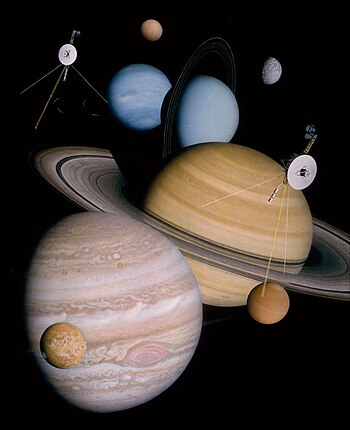
Back Voyager-program Afrikaans برنامج فوياجر Arabic Voyager AST Voyacer proqramı Azerbaijani وویجر برنامهسی AZB Касмічная праграма «Вояджэр» Byelorussian Вояджэр (касьмічная праграма) BE-X-OLD Вояджър (програма) Bulgarian ভয়েজার কর্মসূচি Bengali/Bangla Program "Voyager" BS

The Voyager program is an American scientific program that employs two interstellar probes, Voyager 1 and Voyager 2. They were launched in 1977 to take advantage of a favorable alignment of the two gas giants Jupiter and Saturn and the ice giants, Uranus and Neptune, to fly near them while collecting data for transmission back to Earth. After launch, the decision was made to send Voyager 2 near Uranus and Neptune to collect data for transmission back to Earth.[1]
As of 2024,[update] the Voyagers are still in operation beyond the outer boundary of the heliosphere in interstellar space. Voyager 1 is moving with a velocity of 61,198 kilometers per hour (38,027 mph), or 17 km/s, relative to the Sun, and is 24,475,900,000 kilometers (1.52086×1010 mi) from the Sun[2] reaching a distance of 162 AU (24.2 billion km; 15.1 billion mi) from Earth as of May 25, 2024.[3] On 25 August 2012, data from Voyager 1 indicated that it had entered interstellar space.[4]
As of 2024[update], Voyager 2 is moving with a velocity of 55,347 kilometers per hour (34,391 mph), or 15 km/s, relative to the Sun, and is 20,439,100,000 kilometers (1.27003×1010 mi) from the Sun[5] reaching a distance of 136.627 AU (20.4 billion km; 12.7 billion mi) from Earth as of May 25, 2024.[3] On 5 November 2019, data from Voyager 2 indicated that it also had entered interstellar space.[6] On 4 November 2019, scientists reported that, on 5 November 2018, the Voyager 2 probe had officially reached the interstellar medium (ISM), a region of outer space beyond the influence of the solar wind, as did Voyager 1 in 2012.[7][8][9] As of 2023, Voyager 2 remains the only spacecraft to have ever visited the ice giants Uranus and Neptune.
In August 2018, NASA confirmed, based on results by the New Horizons spacecraft, the existence of a "hydrogen wall" at the outer edges of the Solar System that was first detected in 1992 by the two Voyager spacecraft.[10][11][12]
- ^ "The Fantastic Voyage of Voyager". The Attic. 9 January 2020. Archived from the original on 13 April 2020. Retrieved 3 March 2020.
- ^ "Voyager Mission Status". JPL. Archived from the original on 1 January 2018. Retrieved 10 February 2022.
- ^ a b "Voyager – Mission Status". Jet Propulsion Laboratory. National Aeronautics and Space Administration. Archived from the original on 1 January 2018. Retrieved 24 April 2021.
- ^ Cite error: The named reference
JPL.NASAwas invoked but never defined (see the help page). - ^ "In Depth – Voyager 2". JPL. Archived from the original on 20 April 2017. Retrieved 10 February 2022.
- ^ Cite error: The named reference
NASA-20181210was invoked but never defined (see the help page). - ^ University of Iowa (4 November 2019). "Voyager 2 reaches interstellar space – Iowa-led instrument detects plasma density jump, confirming spacecraft has entered the realm of the stars". EurekAlert!. Archived from the original on 13 April 2020. Retrieved 4 November 2019.
- ^ Chang, Kenneth (4 November 2019). "Voyager 2's Discoveries From Interstellar Space – In its journey beyond the boundary of the solar wind's bubble, the probe observed some notable differences from its twin, Voyager 1". The New York Times. Archived from the original on 13 April 2020. Retrieved 5 November 2019.
- ^ "Solar System Exploration". JPL-NASA. Archived from the original on 18 April 2019. Retrieved 19 February 2021.
- ^ Gladstone, G. Randall; et al. (7 August 2018). "The Lyman-α Sky Background as Observed by New Horizons". Geophysical Research Letters. 45 (16): 8022–8028. arXiv:1808.00400. Bibcode:2018GeoRL..45.8022G. doi:10.1029/2018GL078808. S2CID 119395450.
- ^ Letzter, Rafi (9 August 2018). "NASA Spotted a Vast, Glowing 'Hydrogen Wall' at the Edge of Our Solar System". Live Science. Archived from the original on 13 April 2020. Retrieved 10 August 2018.
- ^ "Voyager – Fact Sheet". voyager.jpl.nasa.gov. Archived from the original on 13 April 2020. Retrieved 17 May 2018.
© MMXXIII Rich X Search. We shall prevail. All rights reserved. Rich X Search